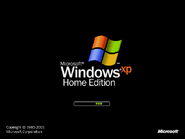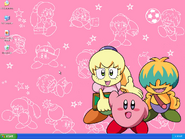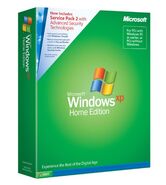The successor to Windows 2000 (both the Millennium and Professional editions), Windows XP was released on October 25, 2001, two months after it was shipped to manufacturing. Back then, only four editions were available -- Starter, Home Basic, Home Premium, and Professional.
Development of Windows XP[]
Build 2202: Pre-Beta 1 (February 2, 2000)[]
Development of Windows XP all started off with this build. In early 2000, the operating system was codenamed "Whistler", and this pre-beta version still looked very much like Windows 2000.
Build 2296: Beta 1 (October 31, 2000)[]
This first beta version of Windows XP, still only known as Whistler back then, contains a new Start menu. Mistakenly, Microsoft announced the final name to be Windows 2001. Yet, this build still has the Windows 2000 startup sound.
Pre-2001 builds of Windows Whistler contained Internet Explorer 5.6. All beta versions of Windows XP as of 2001 now include Internet Explorer 6 Beta.
Build 2462: Beta 2 (March 23, 2001)[]
The first build to use the name "Windows XP" was Build 2462, and it also contains the final startup sound for Windows XP as well as the new Control Panel background and UI.
Build 2505: Release Candidate 1 (July 2, 2001)[]
The Windows XP Preview Program unveiled this build of Windows XP to the public for the remainder of Summer 2001, until the final version was released to manufacturing on August 24.
Release to general availability (October 25, 2001)[]
The Home Basic and Home Premium were available as an Upgrade or a clean installation since the Summer of 2001. The Professional edition, also known as the business counterpart of the Home Basic and Home Premium, offers more features that the Home Basic and Home Premium cannot handle.
The regular clean installation edition costed about $200, while the upgrade costed $100. On the other hand, the Professional edition costed $200 for the upgrade and $300 for the clean installation. This also applied to the Service Pack 2 re-release.
The startup logo now looks a lot different, as it now shows a proper 4:3 resolution. As of Windows XP, you'll have to click on your username icon first before you get started.
What's new in Windows XP[]
- Because of the new design for Windows XP, the Control Panel has two different views -- Category and Classic.
- Windows Explorer looks different from previous operating systems. For example, once you click on a disk drive (floppy, hard disk or CD/DVD), the details will appear instantly.
- The new System Properties screen has lots more tabs.
- There are MANY new features by default, such as DirectX 8.0, a different-looking start menu with two columns (but can easily be switched to Classic mode), and Windows Media Player 8, included exclusively for Windows XP, as it cannot be installed on any operating system other than XP (until 2003, Windows Media Player 7 was current on Windows 98 and 2000).
- There is built-in technology that allows you to burn files to CDs using Windows Explorer.
- Finally, there's Internet Explorer 6, which is supposed to have more enhancements compared to previous versions, but nowadays, it appears to have many security issues. Also included with Windows XP is Outlook Express 6, both of which were released on August 27, 2001, for Windows 98 and 2000.
Professional-only features[]
- Remote Desktop
- Multi-processor support
- Automated System Recovery
- Dynamic Disk Support
- Internet Information Services/Personal Web Server
- Encrypting File System
- File-level access control
- Domain membership
- Multi-language support
- Networking features
And last but not least:
- Upgrade from Windows NT 4.0, 98, Me, and 2000, as you can only upgrade from Windows 98/Me to Windows XP Home Basic and Home Premium.
Service packs[]
Service Pack 1[]
This first service pack was released exclusively online on September 9, 2002. adding support for features such as USB 2.0 and .NET Framework.
Service Pack 2[]
When Service Pack 2 was released on August 25, 2004 as the direct successor to the latest service pack of Windows 2000 (SP4), it included numerous features such as the Internet Explorer Information Bar, Windows Firewall, Windows Security Center, a new Add-On Manager, and enhancements to the Automatic Updates feature. Starting with this OS, Windows now highly recommends Virus Protection to be installed for better use on the PC.
Service Pack 3[]
Released to manufacturing on April 21, 2008, and for public use on May 6, Service Pack 3 was the last service pack for Windows XP. Included in this service pack were over 1,000 fixes.
Media Center Edition[]
The Media Center Edition of Windows XP was released in October 25, 2001. Newer versions were made available through 2006. All versions of the Media Center Edition included Windows Media Center for the first time, with support for recording television programs and the DVR-MS file format.
Included in the 2005 and 2006 Edition were Windows Movie Maker 2.0 and Windows Media Player 10. The version number of Microsoft Windows for this edition was 5.1.2715, instead of 5.1.2600.
Weblinks[]
Main site:
- http://www.microsoft.com/windowsxp (March 2001–January 30, 2007)
Individual versions:
- http://www.microsoft.com/windowsxp/home (Home Basic and Home Premium)
- http://www.microsoft.com/windowsxp/pro (Professional)
- http://www.microsoft.com/windowsxp/mediacenter (Media Center Edition)
The Home and Professional editions' sites launched on May 1, 2001, while the Media Center Edition's launched on January 11, 2002. All sites went defunct in 2008.
Gallery[]
| Operating systems | ||
|---|---|---|
| Microsoft | DOS | 1.x (1981) • 2.x (1983) • 3.x (1984) • 4.0 (1988) • 5.0 (1991) • 6.0 (1993) • 6.22 (1994) |
| Windows | 1.0 (1985) • 2.0 (1987) • 3.0 (1990) • 3.1 (1992) • 95 (1995) • 98 (1998) • 98 SE (1999) • Millennium (2000) | |
| Windows NT | 3.1 (1993) • 3.5 (1994) • 4.0 (1996) • 2000 (2000) • XP (2001) • Vista (2006) • 7 (2009) • 7.1 (2011) • 8 (2012) • 8.1 (2013) • 10 (2015) | |















